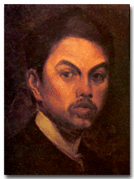Tampuhan (painting)
 | |
| Artist | Juan Luna |
|---|---|
| Year | 1895 |
| Location | Rosalinda Orosa collection |
Tampuhan, meaning "sulking",[1] is an 1895 classic oil on canvas impressionist painting by Filipino painter and hero Juan Luna. It depicts a Filipino man and a Filipino woman having a lovers' quarrel.
Description
Luna's Tampuhan is a depiction of two persons staying inside the sala or living room of a house. The two people are Filipino lovers sulking – experiencing "tampo" – because of an argument. The man is looking out at the street from a window. The woman on the other hand is focusing her eyes on the floor of the room. According to Rosalinda Orosa, the man is Ariston Bautista Lin, a friend of Luna who studied medicine in Europe. Orosa further described that the woman is Emiliana Trinidad. Trinidad is the ancestor of the owner of the painting, and is claimed by Orosa to be the same woman who posed for Luna's La Bulaqueña, another Luna artwork that illustrates Filipino culture.[2]
Relation to Filipino culture
In Filipino courtship, culture, values and psychology, tampuhan (from the Filipino-language root word tampo) or sulking is in essence a disagreement between lovers where they do not speak to each other. This is sometimes called "the silent treatment". Other expressions of sulking in the love life of Filipinos include other non-verbal actions such as not conversing with other people, keeping to one's self, being oddly quiet, non-participation with friends in group activities, non-participation in family outings or other activities, and even merely locking one's self in his or her personal bedroom. To end the sulking, one of the lovers has to coax the other, or both persuade each other to commit to an agreement or compromise.[3]
References
- ↑ Discussion of "Tampuhan" (Sulking) painting by Juan Luna, from "Juan Luna" article, kulay-diwa.com
- ↑ Ocampo, Ambeth. Discussion on Juan Luna's "Tampuhan" painting, from the Who was Luna's La Bulaqueña? article, Looking Back, Anvil Publishing, Inc., National Commission for Culture and the Arts, 11 November 1989: (...) "Tampuhan shows two people, perhaps lovers, seated in the sala of a house. The man is looking out of the window into the street, while the woman has her eyes on the floor, which very likely gives the title "[T]ampuhan" to this canvas (...)
- ↑ “Tampuhan” and “tampo”, seasite.niu.edu
External links
- A poem by Marne L. Kilates based on Luna's Tampuhan painting with a reference to Luna's other painting entitled The Parisian Life.
| ||||||||||||
